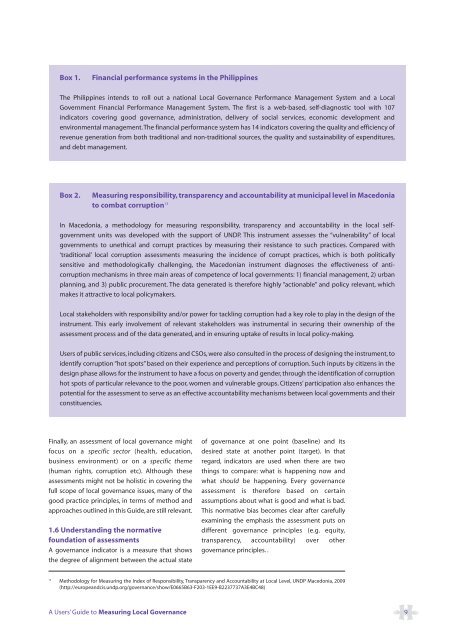A Users' Guide to Measuring Local Governance
A Users' Guide to Measuring Local Governance
A Users' Guide to Measuring Local Governance
Create successful ePaper yourself
Turn your PDF publications into a flip-book with our unique Google optimized e-Paper software.
Box 1.<br />
Financial performance systems in the Philippines<br />
The Philippines intends <strong>to</strong> roll out a national <strong>Local</strong> <strong>Governance</strong> Performance Management System and a <strong>Local</strong><br />
Government Financial Performance Management System. The first is a web-based, self-diagnostic <strong>to</strong>ol with 107<br />
indica<strong>to</strong>rs covering good governance, administration, delivery of social services, economic development and<br />
environmental management.The financial performance system has 14 indica<strong>to</strong>rs covering the quality and efficiency of<br />
revenue generation from both traditional and non-traditional sources, the quality and sustainability of expenditures,<br />
and debt management.<br />
Box 2.<br />
<strong>Measuring</strong> responsibility, transparency and accountability at municipal level in Macedonia<br />
<strong>to</strong> combat corruption 13<br />
In Macedonia, a methodology for measuring responsibility, transparency and accountability in the local selfgovernment<br />
units was developed with the support of UNDP. This instrument assesses the “vulnerability” of local<br />
governments <strong>to</strong> unethical and corrupt practices by measuring their resistance <strong>to</strong> such practices. Compared with<br />
‘traditional’ local corruption assessments measuring the incidence of corrupt practices, which is both politically<br />
sensitive and methodologically challenging, the Macedonian instrument diagnoses the effectiveness of anticorruption<br />
mechanisms in three main areas of competence of local governments: 1) financial management, 2) urban<br />
planning, and 3) public procurement. The data generated is therefore highly “actionable” and policy relevant, which<br />
makes it attractive <strong>to</strong> local policymakers.<br />
<strong>Local</strong> stakeholders with responsibility and/or power for tackling corruption had a key role <strong>to</strong> play in the design of the<br />
instrument. This early involvement of relevant stakeholders was instrumental in securing their ownership of the<br />
assessment process and of the data generated, and in ensuring uptake of results in local policy-making.<br />
Users of public services, including citizens and CSOs, were also consulted in the process of designing the instrument, <strong>to</strong><br />
identify corruption “hot spots” based on their experience and perceptions of corruption. Such inputs by citizens in the<br />
design phase allows for the instrument <strong>to</strong> have a focus on poverty and gender, through the identification of corruption<br />
hot spots of particular relevance <strong>to</strong> the poor, women and vulnerable groups. Citizens’ participation also enhances the<br />
potential for the assessment <strong>to</strong> serve as an effective accountability mechanisms between local governments and their<br />
constituencies.<br />
Finally, an assessment of local governance might<br />
focus on a specific sec<strong>to</strong>r (health, education,<br />
business environment) or on a specific theme<br />
(human rights, corruption etc). Although these<br />
assessments might not be holistic in covering the<br />
full scope of local governance issues, many of the<br />
good practice principles, in terms of method and<br />
approaches outlined in this <strong>Guide</strong>, are still relevant.<br />
1.6 Understanding the normative<br />
foundation of assessments<br />
A governance indica<strong>to</strong>r is a measure that shows<br />
the degree of alignment between the actual state<br />
of governance at one point (baseline) and its<br />
desired state at another point (target). In that<br />
regard, indica<strong>to</strong>rs are used when there are two<br />
things <strong>to</strong> compare: what is happening now and<br />
what should be happening. Every governance<br />
assessment is therefore based on certain<br />
assumptions about what is good and what is bad.<br />
This normative bias becomes clear after carefully<br />
examining the emphasis the assessment puts on<br />
different governance principles (e.g. equity,<br />
transparency, accountability) over other<br />
governance principles. .<br />
13<br />
Methodology for <strong>Measuring</strong> the Index of Responsibility, Transparency and Accountability at <strong>Local</strong> Level, UNDP Macedonia, 2009<br />
(http://europeandcis.undp.org/governance/show/E0665B63-F203-1EE9-B2237737A3E4BC48)<br />
A Users’ <strong>Guide</strong> <strong>to</strong> <strong>Measuring</strong> <strong>Local</strong> <strong>Governance</strong> 9








![GuÃa del Usuario ] - Governance Assessment Portal](https://img.yumpu.com/44740603/1/190x253/gua-a-del-usuario-governance-assessment-portal.jpg?quality=85)







